Although the Intel Xeon L5640 is a lot of processor with very low power consumption requirements, the Intel Xeon X5670 is a much higher-end part. Although quad socket capable, the X5670 is also dual socket capable and fills a position that the Xeon E series does not scale to at this time. The L5640 was fast, but let’s see how adding another 533MHz to twelve physical, twenty-four logical cores fares in terms of performance. At a base clock of 2.93GHz and a turbo clock of 3.33GHz using a 6.4GT/s QPI alongside a higher 95w TDP, one can imagine that performance is going to be stellar.
Test Configuration
The test platform was the same as the dual Intel Xeon E5606 review. I detailed the dual Xeon processor build in an earlier dual processor test bed build log piece. To get power consumption numbers I removed all add-in cards. It should be noted that this build cannot be directly compared to the UP power consumption numbers simply because I am using more fans than normal (most test configurations are single-fan with a PicoPSU). The PicoPSU 150XT could not power this configuration, which frankly makes a lot of sense. The platform has dual IOH36 controllers and an onboard LSI SAS2008 controller. Each IOH36 has a TDP of around 24w. With all of the PCIe lanes, the board offers a TON of expandability beyond the dual CPUs. A PicoPSU 150XT is simply an unrealistic power supply for this configuration.
- CPU: Dual Intel Xeon X5670’s
- Motherboard: Supermicro X8DTH-6F
- Memory: 24GB ECC DDR3 1066MHz DRAM (6x 4GB UDIMMs)
- OS Drive: OCZ Agility 2 120GB
- Additional NICs: None
- Additional RAID Controllers/ HBAs: LSI 9211-8i
- Enclosure: Supermicro SC842TQ-665B
- Power Supply: Supermicro 665w (included in the SC842TQ-665B)
Overall, this is a fairly solid dual Xeon platform that can be used to attach 22 hard drives and that has a ton of expandability.
Performance Tests
I will start off this section by saying that the standard test suite was built to test UP platforms. I have seen repeatedly that at twelve core counts and higher that some of the tests simply do note scale with more cores. As a result, I am adding a few new tests to the suite for the 12-48 physical core reviews. These will be added as I can get them to be repeatable and consistent, but I am getting close, really close on a few.
Windows Experience Index
Personally, I think that Microsoft’s built-in relative performance indicator, the Windows Experience Index (WEI) does not do enough to stress and stratify CPUs, especially at the upper-end. With that being said, a lot of readers ask for WEI scores so I have learned to oblige.

The dual Xeon X5670 configuration is fast, but still does not achieve a 7.9 WEI.
Cinebench R11.5
I have been using Cinebench benchmarks for years but have held off using them on ServeTheHome.com because the primary focus of the site until the past few months has been predominantly storage servers. With the expansion of the site’s scope, Cinebench has been added to the test suite because it does represent a valuable benchmark of multi-threaded performance. I have had quite a few readers contact me about this type of performance for things like servers that are Adobe CS5 compute nodes and similar applications. Cinebench R11.5 is something that anyone can run on their Windows machines to get a relative idea of performance.
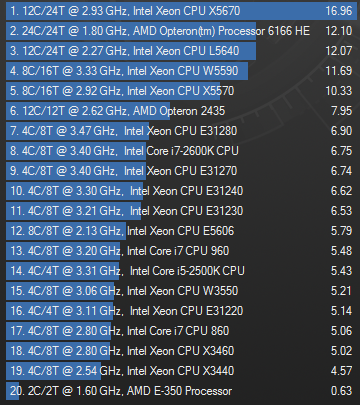
Here the dual Intel Xeon X5670 setup proves to be fast, and amazingly so. Watching Cinebench render was quite a sight at this speed.
7-Zip Compression Benchmark
7-Zip is an immensely popular compression application with an easy to use benchmark.
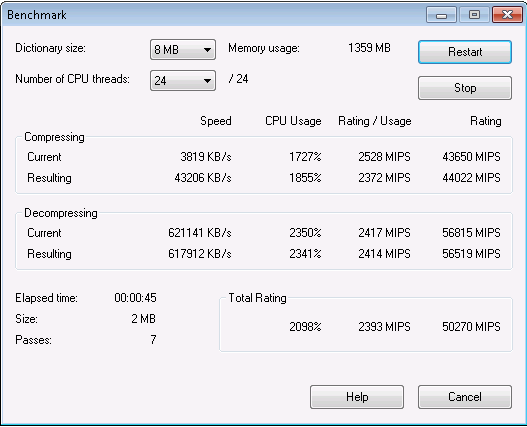
Again the Xeon X5670 turned in very fast times, well ahead of its competition.
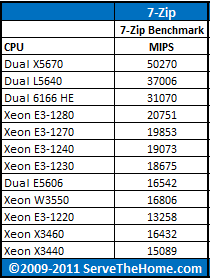
As one can see, the X5670 is able to easily best even 24 physical cores from AMD by a wide margin because of Intel’s clock speed advantage and Hyper-Threading. With the upcoming Interlagos launch AMD needs to be exceeding these figures to be competitive. AMD does have a large gap to bridge with its next-gen server CPUs.
TrueCrypt Encryption Benchmarks
With Intel’s focus on its AES-NI features TrueCrypt can look a bit skewed. Unlike some dubious drivers over the years that were optimized for benchmarks over real world application, Intel’s AES-NI feature does encompass the addition of specialized hardware. This specialized hardware has many practical uses and is becoming more supported. For example, users of Solaris 11 can utilize the AES-NI features to see much higher throughput on encrypted volumes. AMD will be following suit starting with their next generation parts, but for now, the Opteron 6100 series does not have AES acceleration. Without further waiting, here is the dual Intel Xeon X5670 TrueCrypt benchmark run:
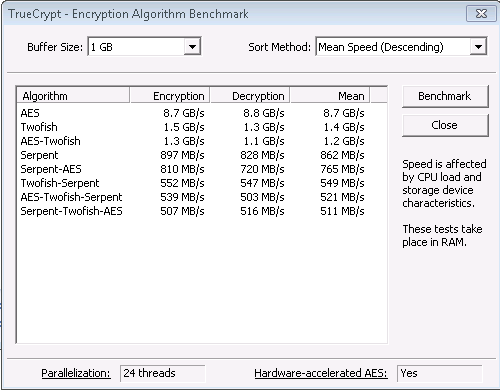
The dual Xeon X5670 configuration absolutely obliterated the TryeCrypt benchmark. Specifically, the hardware accellerated AES test was well beyond anthing this site has tested to date.
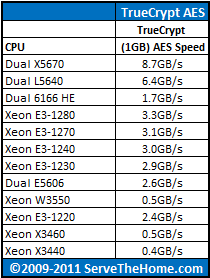
Compared to its competition, the dual Xeon X5670 configuration provides blistering performance. 8.7GB/s is so fast that it is basically enough bandwidth to fill the practical bandwidth limitations of ten 10GbE links simultaneously.
Folding@Home
I am working to make Folding@Home a standardized benchmark, as it is a mature distributed computing client. I will post more information here once I get the methodology perfected and can run this on a few configurations. I will say that I was able to garner 15 minute frame times with this configuration. A frame is equivalent to 1% of the work units completion. For reference, the Opterons were slightly slower than the Dual Xeon X5670’s at about 1 minute per frame slower. The difference being, of course, that the Opteron 6166 HE’s are lower power chips that cost about half of the X5670’s per-chip cost.
Handbrake 0.9.5 x264 Encoding Benchmarks
I am not devoting much time to the standard Handbrake results because, as was seen in the Dual Xeon L5640 and dual 6166 HE review, Handbrake scales really well with up to four cores, and fairly well up to eight. Once twenty four or more threads can be handled at a time the results become inconclusive at best. For those wondering I saw 302fps on the standard definition tests and 42fps on the hi-def tests. That is not an amazing number but still solid.
Power Consumption
One area where the AMD Opteron 6166 HE’s really did well in was power consumption. Running at full load with eight DIMMs one saw 227w, which is very low. On the other hand, the dual Intel Xeon X5670 setup used considerably more power.
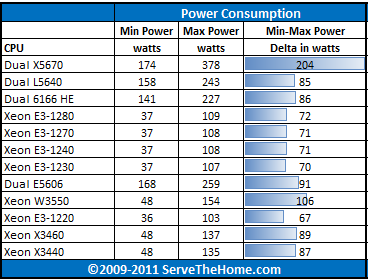
This type of power consumption is not terrible, but certainly not the best out there. On the other hand, when looking for very high-end performance, the dual X5670 setup does not use an egregious amount of power. The Opteron 6166 HE and Xeon L5640 parts are significantly slower, but are marketed and presumably binned as low power parts unlike the Intel Xeon 5670.
Conclusion
This is one of those configurations that offers amazing performance, up to three times Intel’s Sandy Bridge E3 series. One cannot ignore the cost side of the equation, as the chips retail for about $1,400 each making this a relatively expensive configuration. On the other hand, the Xeon X5670 allows one to consolidate several smaller systems into one larger system. In a datacenter environment, spending a bit more per CPU may be worthwhile.




Well 2 X5670 are 3 times faster than E3 serie… 12 cores against 4, so I would say that the speed by core is just the same
please add performance per watt, it’s more important now a days.